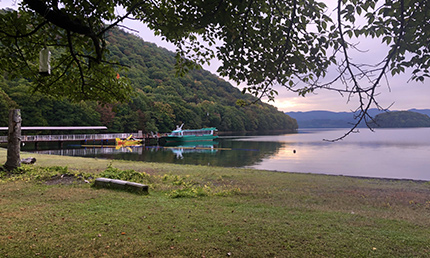Lake Toya and its inner Nakajima Islands make up the center of the Toya-Usu UNESCO Global Geopark and plays a symbolic role in this area. Various hot springs and camps line the shores, and are always crowded with tourists. Rest on the waters with a relaxing boat or canoe ride, or consider a stroll through the forests of Nakajima. You may even encounter deer, squirrels, or woodpeckers.
Understanding the origins of Lake Toya and Nakajima allows you to even better appreciate its nature and landscape.

The scenic view of Lake Toya and the seemingly floating Nakajima Islands changes with every season – truly a blessing from the earth. This beautiful, unique depression is created by volcanic activity known as a caldera. In essence, Lake Toya is a caldera lake that was formed by a volcanic eruption some 110,000 years before. The center islands of Nakajima form the remains of a lava dome that was also from volcanic activity around 50,000 years past.
Lake Toya is one of the highlights of Toya-Usu UNESCO Global Geopark. Many tourists know it as a popular spot for taking photos, but relatively few know that it is also a caldera lake.
The origin of Lake Toya goes back to about 110,000 years ago, during one of the largest eruptions to ever occur in Japan. This huge flow of magma reached as far as the bay of Uchiura-wan to the south and to the Sea of Japan to the west. The deposits of magma filled the current area around Lake Toya, creating a flat hill.
A caldera was created due the land collapsing after large amounts of magma flowed out, and water gradually accumulated in the area, becoming Lake Toya.
Seen from above, Lake Toya spans about 11 km from east to west and 9 km from north to south. It is the third largest caldera lake in Japan.



At the center of the lake is the Nakajima – large and small islands that give Lake Toya its characteristic view. The island is uninhabited and wild animals roam free, although you can still take a boat ride there and trek about.
The name “Nakajima” actually refers to a set of four islands in the center of Lake Toya. The large island of Oshima, and three small islands of Kannon, Benten and Manju. Nakajima is a lava dome formed by an eruption about 50,000 years ago.
These lava domes have been found not only on Nakajima, but also on the bottom of the lake. There is also a spot called “the zero point” – a hidden lava dome just under the surface of the lake, affectionately called “the island that could not be.”



Take a sightseeing boat to Nakajima and surround yourself with trees as you stroll through the forest. As you move along, you can see the remains of volcanic activity that make up the unique topography of the lava dome.
There are various rocks that were formed with holes and gaps, and if you place your hand near them, you can feel the cold air flowing through these wind caves.
Nakajima is home to squirrels, woodpeckers, as well as island deer with their own unique ecology. Although difficult to encounter, if you are lucky you may find yourself across such a deer.

